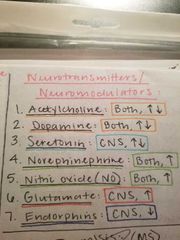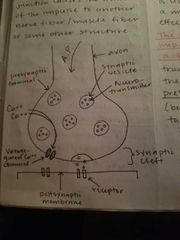![]()
![]()
![]()
Use LEFT and RIGHT arrow keys to navigate between flashcards;
Use UP and DOWN arrow keys to flip the card;
H to show hint;
A reads text to speech;
12 Cards in this Set
- Front
- Back
|
Describe how neuromodulators create presynaptic inhibition and/or presynaptic facilitation |
Neuromodulators are substances released from neurons that influence the likelihood of an AP being produced in a postsynaptic cell. The neuromodulator influences the release of a neurotransmitter from the presynaptic terminal of another neuron. An AP arriving at the presynaptic terminal causes the release of a neurotransmitter, which diffuses across the synaptic cleft and binds to the receptors of the postsynaptic membranes which contain receptors for the neurotransmitter. Presynaptic Inhibition decrease the neurotransmitter release and presynaptic facilitation increases neurotransmitter release. |
|
|
Neurotransmitters/neuromodulators in regards to their effect on the nervous system; inhibitory or excitatory and where their located. |

|
|
|
Describe the structure of a typical synapse |
A synapse is a junction between two nerve cells (where they communicate with each other), consisting of a minute gap across which impulses pass by diffusion of a neurotransmitter- chemical substance that is released at the end of a nerve fiber by the arrival of a nerve fiber by the arrival of a nerve impulse and by diffusing across the synapse/junction causes the transfer of the impulse to another nerve fiber/muscle fiber or some other structure. |
|
|
Picture of a synapse |

|
|
|
What are the 2 types of synapses? |
Electrical synapses and chemical synapses |
|
|
What is a electrical synapse? |
Electrical synapses occur between cells connected by gap junctions, in which the gap junctions allow a local current to flow directly from one cell to a neighboring cell. (Doesnt involve a neurotransmitter, Not very common) |
|
|
What is a chemical synapse? |
Chemical synapses occur where a chemical messenger (neurotransmitter) is used to communicate a message to an effector. (Most common type of synapse) |
|
|
Describe the ways a nervous impulse travels across a synapse |
The cell that transmits the signal toward the synapse is called the presynaptic cell (before the synapse) and the target cell receiving the signal is called the postsynaptic cell (after the synapse) |
|
|
What is the point of a AP? |
The point of an AP is to release a neurotransmitter (exocytosis) |
|
|
How does a neuron reach threshold? |
Summation Spatial- multiple stimuli at once Temporal- occurring in time, one individual stimulus, over and over again |
|
|
Conduction speeds in neurons. What are the 3 types? |
Type A- pain, temperature, some touch Type B- sensory from organs, some ANS neurons Type C- some ANS, few sensory neurons |
|
|
Why such a big range of speed? What are the 3 types of neurons? |
Big diameter, insulated wire (myelin sheath) In Type A neurons- thickest diameter/myelin sheath (fastest) In Type B neurons- medium diameter/myelin sheath. In Type C neurons- smallest diameter/no myelin sheath |

